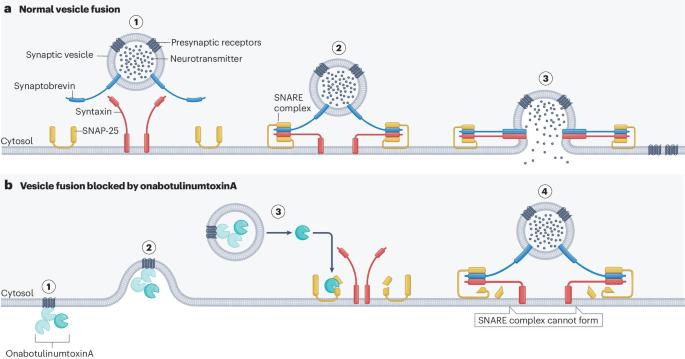Insights from 25 years of onabotulinumtoxinA in migraine — mechanisms and management
IF 28.2
1区 医学
Q1 CLINICAL NEUROLOGY
引用次数: 0
Abstract
OnabotulinumtoxinA (BTX-A) was first linked to beneficial effects in migraine 25 years ago and was approved by the FDA for preventive treatment of chronic migraine in 2010. The treatment has since had a major impact on the well-being of people with chronic migraine. The clinical development programme for BTX-A and research since its approval have provided insights into the neuromodulatory sensory effect of BTX-A, how it can control chronic migraine despite its peripheral action, and the underlying biology of migraine as a disease. In this Review, we consider the impact that BTX-A has had on the management of chronic migraine and on the research field. We discuss the insights provided by clinical research, encompassing the clinical trials and subsequent real-world evidence, and the mechanistic insights provided by preclinical and translational research. We also provide an overview of future directions of research in the field BTX-A in migraine and the clinical translation of this research. OnabotulinumtoxinA was first linked to beneficial effects in migraine 25 years ago and has since become a widely used treatment for chronic migraine. In this Review, Pozo-Rosich and colleagues consider the impact that onabotulinumtoxinA has had on the management of chronic migraine and on the research field.


25 年来在偏头痛治疗中使用鬼臼毒素的启示--机制与管理
25年前,OnabotulinumtoxinA(BTX-A)首次对偏头痛产生了有益的影响,并于2010年被美国食品及药物管理局批准用于慢性偏头痛的预防性治疗。自此,该疗法对慢性偏头痛患者的健康产生了重大影响。BTX-A的临床开发计划和获批后的研究工作让人们深入了解了BTX-A的神经调节感觉效应、BTX-A如何在外周作用的情况下控制慢性偏头痛,以及偏头痛这种疾病的潜在生物学特性。在本综述中,我们将探讨BTX-A对慢性偏头痛治疗和研究领域的影响。我们讨论了临床研究(包括临床试验和随后的实际证据)提供的见解,以及临床前研究和转化研究提供的机理见解。我们还概述了偏头痛 BTX-A 领域的未来研究方向以及该研究的临床转化。
本文章由计算机程序翻译,如有差异,请以英文原文为准。
求助全文
约1分钟内获得全文
求助全文
来源期刊

Nature Reviews Neurology
医学-临床神经学
CiteScore
29.90
自引率
0.80%
发文量
138
审稿时长
6-12 weeks
期刊介绍:
Nature Reviews Neurology aims to be the premier source of reviews and commentaries for the scientific and clinical communities we serve. We want to provide an unparalleled service to authors, referees, and readers, and we work hard to maximize the usefulness and impact of each article. The journal publishes Research Highlights, Comments, News & Views, Reviews, Consensus Statements, and Perspectives relevant to researchers and clinicians working in the field of neurology. Our broad scope ensures that the work we publish reaches the widest possible audience. Our articles are authoritative, accessible, and enhanced with clearly understandable figures, tables, and other display items. This page gives more detail about the aims and scope of the journal.
 求助内容:
求助内容: 应助结果提醒方式:
应助结果提醒方式:


